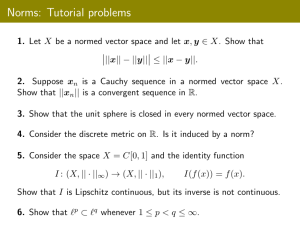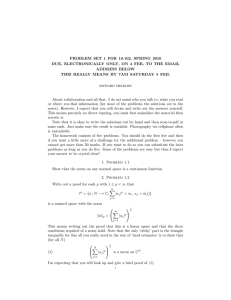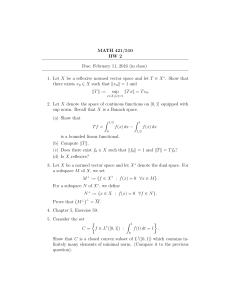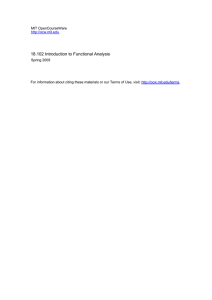18.102 Introduction to Functional Analysis
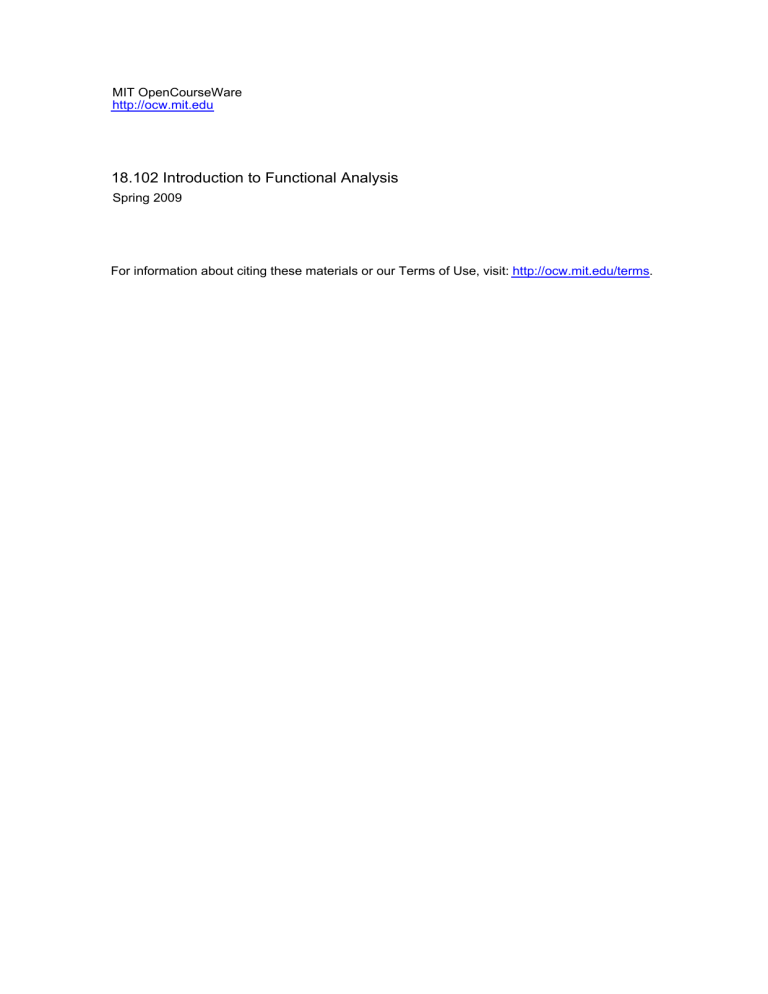
MIT OpenCourseWare http://ocw.mit.edu
18.102 Introduction to Functional Analysis
Spring 2009
For information about citing these materials or our Terms of Use, visit: http://ocw.mit.edu/terms .
8 LECTURE NOTES FOR 18.102, SPRING 2009
Lecture 3.
Tuesday, 10 Feb.
Recalled the proof from last time that the bounded operators from a normed space into a Banach space form a Banach space – mainly to suggest that it is not so hard to remember how such a proof goes.
Then proved that a normed space is
Banach iff every ‘absolutely summable’ series is convergent.
Absolute summability means that the sum of the norms is finite.
Then did most of the proof that every normed space can be completed to a Banach space using this notion of absolutely summable sequences.
The last part – and a guide to how to attempt the part of the proof that is the first question on the next homework.
The proof of the result about completeness from the early part of the leture is in
(1) Wilde:- Proposition 1.6
(2) Chen:- I didn’t find it.
(3) Ward:- Lemma 2.1
(easy way only)
Here is a slightly abbreviated version of what I did in lecture today on the completion of a normed space.
The very last part I asked you to finish as the first part of the second problem set, not due until February 24 due to the vagaries of the
MIT calendar (but up later today).
This problem may seem rather heavy sledding but if you can work through it all you will understand, before we get to it, the main sorts of arguments needed to prove most of the integrability results we will encounter later.
Let V be a normed space with norm � · �
V
.
A completion of V is a Banach space
B with the following properties:
(1) There is an injective (1-1)linear map I : V −→ B
(2) The norms satisfy
(3.1) � I ( v ) �
B
= � v �
V
∀ v ∈ V.
(3) The range I ( V ) ⊂ B is dense in B.
Notice that if V is itself a Banach space then we can take B = V with I the identity map.
So, the main result is:
Theorem 1.
Each normed space has a completion.
‘Proof ’ (the last bit is left to you).
First we introduce the rather large space
� �
(3.2) = { u k
}
∞ k =1
; u k
∈ V and
∞
�
� u k
� < ∞ k =1 the elements of which I called the absolutely summable series in V.
–
Now, I showed in the earlier result that each element of V meaning the corresponding sequence of partial sums v
N is a Cauchy sequence
=
N
� k =1 u k is Cauchy if
{ u k
} is absolutely summable.
Now V is a linear space, where we add and multiply by constants, by doing the operations on each component: sequences,
(3.3) t
1
{ u k
} + t
2
{ u
� k
} = { t
1 u k
+ t
2 u
� k
} .
This always gives an absolutely summable series by the triangle inequality:
(3.4)
�
� t
1 u k
+ t
2 u
� k
� ≤ | t
1
|
�
� u k
� + | t
2
|
�
� u
� k
� .
k k k
LECTURE NOTES FOR 18.102, SPRING 2009 9
Within
�
(3.5) consider the linear subspace
�
S = { u k
} ;
�
� u k
� < ∞ ,
� u k
= 0
� k k of those which converge to 0 .
As always for a linear subspace of a linear space we can form the quotient
(3.6) B =
�
/S the elements of which are the ‘cosets’ of the form { u k
} + S ⊂ V
We proceed to check the following properties of this B.
where { u k
} ∈ V .
(1) A norm on B is defined by
(3.7) � b �
B n
�
= lim n →∞
� k =1 u k
� , { u k
} ∈ b.
(2) The original space V is imbedded in B by
(3.8) V � v �−→ I ( v ) = { u k
} + S, u
1
= v, u k
= 0 ∀ k > 1 and the norm satisfies (3.1).
(3) I ( V ) ⊂ B is dense.
(4) B is a Banach space with the norm (3.7).
So, first that (3.7) is a norm.
The limit on the right does exist since the limit of the norm of a Cauchy sequence always exists – namely the sequence of norms is itself Cauchy but now in
R
.
Moreover, adding an element of S to { u k
} does not change the norm of the sequence of partial sums, since the addtional term tends to zero means in norm.
exactly
Thus that the
� b �
B is well-defined for each element b ∈ B and � b �
B sequence { u k
= 0
} used to define it tends to 0 in norm, hence is in S hence b = 0 .
The other two properties of norm are reasonably clear, since if
{ b, tu k b
}
� ∈ B are represented by { u k and { u k
+ u
� k
} and
} , { u
� k
} in V then tb and b + b
� are reprented by
(3.9) n
� lim n →∞
� k =1 tu k
� = t lim n →∞
� n
� u k k =1
� , n
� lim n →∞
� k =1
( u k
+ u
� k
) � = A = ⇒ n
� for � > 0 ∃ N s.t.
∀ n ≥ N, A − � ≤ � ( u k
+ u
� k
) � = ⇒ k =1 n
�
A − � ≤ � u k n
�
� + � u
� k
) � ∀ n ≥ N = ⇒ k =1 k =1
A − � ≤ � b �
B
+ � b
�
�
B
∀ � > 0 = ⇒
� b + b
�
�
B
≤ � b �
B
+ � b
�
�
B
.
Now the norm of the element I ( v ) = v, 0 , 0 , · · · , is the limit of the norms of the sequence of partial sums and hence is � v �
V so � I ( v ) �
B
= � v �
V and I ( v ) = 0 therefore implies v = 0 and hence I is also injective.
So, we need to check that B is complete, and also that I ( V ) is dense.
Here is an extended discussion of the difficulty – of course maybe you can see it directly
10 LECTURE NOTES FOR 18.102, SPRING 2009 yourself (or have a better scheme).
Note that I want you to write out your own version of it carefully for the next problem set.
Okay, what does it mean for B to be a Banach space, well as we saw in class today it means that every absolutely summable series in B is convergent.
Such a series { b n
} is given by b n
= { u
( n ) k
} + S where { u
( n ) k
} ∈
� and the summability condition is that
(3.10) ∞ >
�
� b n
�
B
=
� n lim
N →∞
�
N
� k =1 u
( n ) k
�
V
.
So, we want to show that n
� b n n
= b converges, and to do so we need to find the limit b.
It is supposed to be given by an absolutely summable series.
The ‘problem’ is that this series should look like � � u
( n ) k in some sense – because it is supposed n k to represent the sum of the b n
(3.11)
’s.
Now, it would be very nice if we had the estimate
� �
� u
( n ) k
�
V
< ∞ n k since this should allow us to break up the double sum in some nice way so as to get an absolutely summable series out of the whole thing.
The trouble is that (3.11) need not hold.
We know that each of the sums over k – for given n – converges, but not the sum of the sums.
All we know here is that the sum of the ‘limits of the norms’ in (3.10) converges.
So, that is the problem!
One way to see the solution is to note that we do not have to choose the original { u
( n ) k
} to ‘represent’ b n
– we can add to it any element of S.
One idea is to rearrange the u
( n ) k
– I am thinking here of fixed n – so that
‘converges even faster.’ Given � > 0 we can choose N
1
(3.12) |�
� u
( N ) k
�
V
− � b n
�
B
| ≤ �,
�
� u so
( n ) k
� that
V
≤ for
�.
all N ≥ N
1
, it k ≤ N k ≥ N
Then in fact we can choose successive N j here) so that
(3.13) |�
� u
( N ) k
�
V
− � b n
�
B
| ≤ 2
< N
− j
�, j − 1
�
(remember
� u
( n ) k
�
V
≤ that
2
− j little
�.
n is fixed k ≤ N j k ≥ N j
Now, ‘resum the series’ defining instead v
( n )
1
=
N
1
� k =1
( n ) u k
, v
( n ) j this setting � = 2 − n
(3.14) for the n th series.
Check that now
� �
� v
( n ) k
�
V
< ∞ .
n k
=
N j
� k = N j − 1 u
( n ) k and do
Of course, you should also check that b n
= { v
( n ) k
} + S so that these new summable series work just as well as the old ones.
After this fiddling you can now try to find a limit for the sequence as
(3.15) b = { w k
} + S, w k
=
� ( p ) v l
∈ V.
l + p = k
So, you need to check that this { w k
} is absolutely summable in V and that b n
→ b as n → ∞ .
I may add some more to discussion of completeness if needed.
LECTURE NOTES FOR 18.102, SPRING 2009 11
Finally then there is the question of showing that I ( V ) is dense in B.
You can do this using the same idea as above – in fact it might be better to do it first.
Given an k element
→ ∞ .
b
Take
∈ B an we need absolutely to find elements summable series in u
V, k v k such that � I ( v k representing b and
) − b �
B take v j
→ 0 as
=
N j
� u k k =1 where the N j
’s are constructed as above and check that I ( v j
� �
) → b by computing
(3.16) � I ( v j
) − b �
B
= lim p →∞
� p>N j u p
�
V
≤ p>N j
� u p
�
V
.
�
12 LECTURE NOTES FOR 18.102, SPRING 2009
Problem set 2, Due 11AM Tuesday 24 Feb.
I was originally going to make this problem set longer, since there is a missing
Tuesday.
However, I would prefer you to concentrate on getting all four of these questions really right!
Problem 2.1
Finish the proof of the completeness of the space B constructed in lecture on February 10.
The description of that construction can be found in the notes to Lecture 3 as well as an indication of one way to proceed.
Problem 2.2
Let’s consider an example of an absolutely summable sequence of step functions.
For the interval [0 , 1) (remember there is a strong preference for left-closed but right-open intervals for the moment) consider a variant of the construction of the standard Cantor subset based on 3 proceeding in steps.
Thus, remove the ‘central interval [1 / 3 , 2 / 3) .
This leave C
1
= [0 , 1 / 3) ∪ [2 / 3 , 1) .
Then remove the central interval from each of the remaining two intervals to get C
2
=
[0 , 1 / 9) ∪ [2 / 9 , 1 / 3) ∪ [2 / 3 , 7 / 9) ∪ [8 / 9 , 1) .
Carry on in this way to define successive sets C k
⊂ C k − 1
, each consisting of a finite union of semi-open intervals.
Now, consider the series of step functions f k where f k
( x ) = 1 on C k and 0 otherwise.
(1)
(2)
Check
For that which x this
∈ [0 is
, an
1) absolutely does � | f k
( summable x ) | series.
converge?
k
(3) Describe a function on [0 , 1) which is shown to be Lebesgue integrable
(as defined in Lecture 4) by the existence of this series and compute its
Lebesgue integral.
(4) Is this function Riemann integrable (this is easy, not hard, if you check the definition of Riemann integrability)?
(5) Finally consider the function g which is equal to one on the union of all the intervals which are removed in the construction and zero elsewhere.
Show that g is Lebesgue integrable and compute its integral.
the
Problem 2.3
The covering lemma for
R
2
.
By a rectangle we will mean a set of form [ a
1
, b
1
) × [ a
2
, b
2
) in
R
2
.
The area of a rectangle is ( b
1
− a
1
) × ( b
2
− a
2
) .
(1) We may subdivide a rectangle by subdividing either of the intervals – re placing [ a
1
, b
1
) by [ a
1
, c
1
) ∪ [ c
1
, b
1
) .
Show that the sum of the areas of rectangles made by any repeated subdivision is always the same as that of the original.
(2) Suppose that a finite collection of disjoint rectangles has union a rectangle
(always in this same half-open sense).
Show, and I really mean prove, that the sum of the areas is the area of the whole rectange.
Hint:- proceed by subdivision.
(3) Now show that for any countable collection of disjoint rectangles contained in a given rectange the sum of the areas is less than or equal to that of the containing rectangle.
(4) Show that if a finite collection of rectangles has union containing a given rectange then the sum of the areas of the rectangles is at least as large of that of the rectangle contained in the union.
(5) Prove the extension of the preceeding result to a countable collection of rectangles with union containing a given rectangle.
Problem 2.4
LECTURE NOTES FOR 18.102, SPRING 2009 13
(1) Show that any continuous function on [0 , 1] is the uniform limit on [0 , 1) of a sequence of step functions.
Hint:- Reduce to the real case, divide the interval into 2 n equal pieces and define the step functions to take infimim of the continuous function on the corresponding interval.
Then use uniform convergence.
(2) By using the ‘telescoping trick’ show that any continuous function on [0 , 1)
(3.17) can be written as the sum
� f j
( x ) ∀ x ∈ [0 , 1) where the f j i
� are step functions and | f j
( x ) | < ∞ for all x ∈ [0 , 1) .
j
(3) Conclude that any continuous function on [0 , 1] , extended to be 0 outside this interval, is a Lebesgue integrable function on
R
.
14 LECTURE NOTES FOR 18.102, SPRING 2009
Solutions to Problem set 1
Full marks will be given to anyone who makes a good faith attempt to answer each question.
The first four problems concern the ‘little L p’ spaces l p .
Note that you have the choice of doing everything for p = 2 or for all 1 ≤ p < ∞ .
Everyone who handed in a script received full marks.
Problem 1.1
Write out a proof (you can steal it from one of many places but at least write it out in your own hand) either for p = 2 or for each p with 1 ≤ p < ∞ that l p
∞
�
= { a :
N
−→
C
; | a j
| p
< ∞ , a j
= a ( j ) } j =1 is a normed space with the norm
� a � p
⎛
∞
�
=
⎝
| a j
| p
⎞
1 p
⎠
.
j =1
This means writing out the proof that this is a linear space and that the three conditions required of a norm hold.
Solution:- We know that the functions from any set with values in a linear space form a linear space – under addition of values (don’t feel bad if you wrote this out, it is a good thing to do once).
So, to see that l p is a linear space it suffices to see that it is closed under addition and scalar multiplication.
For scalar multiples this is clear:
(3.18) | ta i
| = | t || a i
| so � ta � p
= | t |� a � p which is part of what is needed for the proof that � · � p that a, b ∈ l p imples a + b ∈ l p follows once we show is the a norm triangle anyway.
The inequality or fact we can be a little cruder and observe that
(3.19)
| a i
+ b i
| p
≤
�
(2 max( a + b � p p
| a | i
, | b i
=
�
| )) p
| a i
= 2
+ b i
| p p max( | a |
≤ 2 p
( � p i a
, | b
� p i
| p
) ≤
+ � b � p
2
) , p
( | a i
| + | b i
| ) j where we use the fact that t p is an increasing function of t ≥ 0 .
Now, to see that l p is a normed space we need to check that � a � p norm.
It is non-negative and � a � p
= 0 implies a i
= 0 for all i which is to is indeed say a = 0 a
.
So, only the triangle inequality remains.
For p = 1 this is a direct consequence of the usual triangle inequality:
(3.20) � a + b �
1
�
= | a i
+ b i
�
| ≤ ( | a i
| + | b i
| ) = � a �
1
+ � b �
1
.
i i
For 1 < p < ∞ it is known as Minkowski’s inequality.
This in turn is deduced from H¨ inequality – which follows from Young’s inequality!
The latter says if 1 /p + 1 /q = 1 , so q = p/ ( p − 1) , then
(3.21)
α
αβ ≤ + ∀ α, β ≥ 0 .
p p β q q
To check it, observe that as a function of α = x,
(3.22) x p f ( x ) = − xβ + p
β q q
LECTURE NOTES FOR 18.102, SPRING 2009 15 if non-negative at x = 0 and clearly positive when x >> 0 , since x p grows faster than xβ.
Moreover, it is differentiable and the derivative only vanishes at x p − 1
=
β, where it must have a global minimum in x > 0 .
At this point f ( x ) = 0 so
Young’s inequality follows.
Now, applying this with α = | a i
| / � a � p and β = | b i
| / � b � q
(assuming both are non-zero) and summing over i gives H¨ inequality
(3.23)
|
� i a i b i
| / � a � p
� b � q
≤
�
| a i
|| b i
| / � a � p
� b � q
≤
�
� i
| a i
� a �
| p p p p
| b
+
� b i
|
� q q q q
�
= 1 i
�
= ⇒ | a i b i
| ≤ � a � p
� b � q
.
i
Of course, if either � a � p
= 0 or � b � q
= 0 this inequality holds anyway.
Now, from this Minkowski’s inequality follows.
Namely from the ordinary trian gle inequality and then Minkowski’s inequality (with q power in the first factor)
(3.24)
�
| a i
+ b i
| p �
= | a i
+ b i
| ( p − 1) | a i
+ b i
| i
≤
� i
| a i
+ b i
| ( p − 1) | a i
�
| + | a i
+ b i
| ( p − 1) | b i
| i i
≤
�
�
| a i
+ b i
| p
�
1 /q
( � a � p
+ � b � q
) i gives after division by the first factor on the right
(3.25) � a + b � p
≤ � a � p
+ � b � p
.
Thus, l p is indeed a normed space.
I did not necessarily expect you to go through the proof of Young-H¨
Minkowksi, but I think you should do so at some point since I will not do it in class.
Problem 1.2
The ‘tricky’ part in Problem 1.1
is the triangle inequality.
Suppose you knew – meaning I tell you – that for each N
⎛
N
�
⎝
| a j
| p
⎞
1 p
⎠ is a norm on
C
N j =1 would that help?
Solution:- Yes indeed it helps.
If we know that for each N
(3.26)
⎛
N
�
⎝
| a j
+ b j
| p
⎞
⎠
1 p
⎛
N
�
≤
⎝
| a j
| p
⎞
1 p
⎛
N
�
⎠
+
⎝
| b
⎞ j
| p
⎠
1 p j =1 j =1 j =1 then for elements of l p the norms always bounds the right side from above, meaning
(3.27)
⎛
N
�
⎝
| a j
+ b j
| p
⎞
1 p
⎠
≤ � a � p
+ � b � p
.
j =1
Since the left side is increasing with N it must converge and be bounded by the right, which is independent of N.
That is, the triangle inequality follows.
Really
16 LECTURE NOTES FOR 18.102, SPRING 2009 this just means it is enough to go through the discussion in the first problem for finite, but arbitrary, N.
Problem 1.3
Prove directly that each l p as defined in Problem 1.1
– or just l 2 – is complete, i.e.
it is a Banach space.
At the risk of offending some, let me say that this means showing that each Cauchy sequence converges.
The problem here is to find the limit of a given Cauchy sequence.
Show that for each N the sequence in
C
N obtained by truncating each of the elements at point N is Cauchy with respect to the norm in
Problem 1.2
on
C
N .
Show that this is the same as being Cauchy in
C
N in the usual sense (if you are doing p = 2 it is already the usual sense) and hence, this cut-off sequence converges.
Use this to find a putative limit of the Cauchy sequence and then check that it works.
Solution:- So, suppose we are given a Cauchy sequence a ( n ) element is a sequence { a
( n ) j
} ∞ j =1 in l p .
From the continuity of the in l p .
norm
Thus, in each
Problem
1.5
below, � a
( n ) � must be Cauchy in
R and so converges.
In particular the sequence is norm bounded, there exists A such that � a ( n ) � p
≤ A for all n.
The Cauchy condition itself is that given � > 0 there exists M such that for all m, n > M,
(3.28) � a
( n ) − a
( m ) � p
=
�
�
| a
( n ) i
− a
( i m )
| p
�
1 p i
< �/ 2 .
Now for each i, | a
( n ) i
− a
( m ) i
| ≤ � a ( n ) be Cauchy in
C
.
Since
C is complete
− a ( m ) � p so each of the sequences a
( n ) i must
(3.29) lim a n →∞
( n ) i
= a i exists for each i = 1 , 2 , . . . .
So, our putative limit is a, the sequence { a i
} ∞ i =1
.
shows that
The boundedness of the norms
(3.30)
N
�
| a
( n ) i
| p ≤ A p i =1 and we can pass to the limit here as n → ∞ since there are only finitely many terms.
Thus
(3.31)
N
�
| a i
| p ≤ A p ∀ N = ⇒ � a � p
≤ A.
i =1
Thus, a ∈ l p as we hoped.
Similarly, we can pass to the limit as m → ∞ in the finite inequality which follows from the Cauchy conditions
(3.32) (
N
�
| a
( n ) i i =1
− a
( m ) i
| p
)
1 p < �/ 2 to see that for each N
(3.33) (
N
�
| a
( n ) i
− a i
)
1
| p p
≤ �/ 2 i =1 and hence
(3.34) � a
( n ) − a � < � ∀ n > M.
Thus indeed, a ( n ) → a in l p as we were trying to show.
LECTURE NOTES FOR 18.102, SPRING 2009 17
Notice that the trick is to ‘back off’ to finite sums to avoid any issues of inter changing limits.
Problem 1.4
Consider the ‘unit sphere’ in l p the set of vectors of length 1 :
– where if you want you can set p = 2 .
This is
S = { a ∈ l p
; � a � p
= 1 } .
(1) Show that S is closed.
(2) Recall the sequential (so not the open covering definition) characterization of compactness of a set in a metric space (e.g.
by checking in Rudin).
(3) Show that S is not compact by considering the sequence in l p with k th element the sequence which is all zeros except for a 1 in the k th slot.
Note that the main problem is not to get yourself confused about sequences of sequences!
Solution:- By the next problem, the norm is continuous as a function, so
(3.35) S = { a ; � a � = 1 } is the inverse image of the closed subset { 1 } , hence closed.
Now, the standard result on metric spaces is that a subset is compact if and only if every sequence with values in the subset has a convergent subsequence with limit in the subset (if you drop the last condition then the closure is compact).
In this case we consider the sequence (of sequences)
�
0 i = n
(3.36) a
( n ) i
=
1 i = n
.
This has the property that � a ( n ) − a ( m ) � p
1
= 2 p whenever n = m.
Thus, it cannot have any Cauchy subsequence, and hence cannot have a convergent subsequence, so S is not compact.
This is important.
In fact it is a major difference between finite-dimensional and infinite-dimensional normed spaces.
In the latter case the unit sphere cannot be compact whereas in the former it is.
Problem 1.5
Show that the norm on any normed space is continuous.
Solution:- Right, so I should have put this problem earlier!
The triangle inequality shows that for any u, v in a normed space
(3.37) � u � ≤ � u − v � + � v � , � v � ≤ � u − v � + � u � which implies that
(3.38) |� u � − � v �| ≤ � u − v � .
This shows that � · � is continuous, indeed it is Lipschitz continuous.
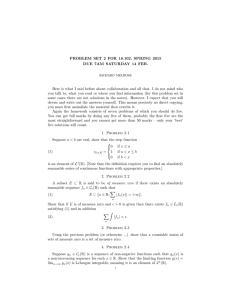

![Mathematics 321 2008–09 Exercises 4 [Due Monday January 12th.]](http://s2.studylib.net/store/data/010730635_1-187d521e2b18d0cc940a7589784fb631-300x300.png)
